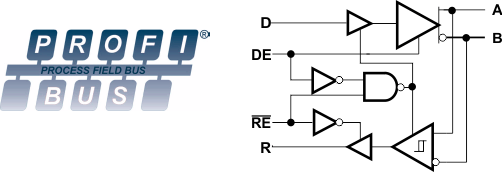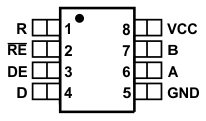-
SNx5HVD1176 PROFIBUS® RS-485 Transceivers SLLS563I July 2003 – January 2023 SN65HVD1176 , SN75HVD1176
PRODUCTION DATA
-
SNx5HVD1176 PROFIBUS® RS-485 Transceivers
- 1 Features
- 2 Applications
- 3 Description
- 4 Revision History
- 5 Pin Configuration and Functions
- 6 Specifications
- 7 Detailed Description
- 8 Application and Implementation
- 9 Power Supply Recommendations
- 10Layout
- 11Device and Documentation Support
- 12Mechanical, Packaging, and Orderable Information
- IMPORTANT NOTICE
Package Options
Mechanical Data (Package|Pins)
- D|8
Thermal pad, mechanical data (Package|Pins)
Orderable Information
SNx5HVD1176 PROFIBUS® RS-485 Transceivers
1 Features
- Optimized for PROFIBUS® networks
- Signaling rates up to 40 Mbps
- Differential output
exceeds 2.1 V
(54-Ω load) - Low bus capacitance of 10 pF (Max)
- Meets the requirements of TIA/EIA-485-A
- ESD Protection exceeds ±10-kV HBM
- Fail-safe receiver for bus open, short, idle
- Up to 160 transceivers on a bus
- Low skew during output transitions and driver enabling and disabling
- Common-mode rejection up to 50 MHz
- Short-circuit current limit
- Hot swap capable
- Thermal shutdown protection
2 Applications
- Process automation
- Chemical production
- Brewing and distillation
- Paper mills
- Factory automation
- Automobile production
- Rolling, pressing, stamping machines
- Networked sensors
- General RS-485 networks
- Motor and motion control
- HVAC and building automation networks
- Networked security stations
3 Description
The SNx5HVD1176 devices are half-duplex differential transceivers with characteristics optimized for use in PROFIBUS (EN 50170) applications. The driver output differential voltage exceeds the PROFIBUS requirements of 2.1 V with a 54-Ω load. A signaling rate of up to 40 Mbps allows technology growth to high data-transfer speeds. The low bus capacitance provides low signal distortion.
The SN65HVD1176 and SN75HVD1176 devices meet or exceed the requirements of ANSI standard TIA/EIA-485-A (RS-485) for differential data transmission across twisted-pair networks. The driver outputs and receiver inputs are tied together to form a half-duplex bus port with one-fifth unit load, which allows up to 160 nodes on a single bus. The receiver output stays at logic high when the bus lines are shorted, left open, or when no driver is active. The driver outputs are in high impedance when the supply voltage is below 2.5 V to prevent bus disturbance during power cycling or during live insertion to the bus. An internal current limit protects the transceiver bus pins in short-circuit fault conditions by limiting the output current to a constant value. Thermal shutdown circuitry protects the device against damage due to excessive power dissipation caused by faulty loading and drive conditions.
The SN75HVD1176 device is characterized for operation at temperatures from 0°C to 70°C. The SN65HVD1176 device is characterized for operation at temperatures from –40°C to 85°C.
For an isolated version of this device, see the ISO1176 device (SLLS897) with integrated digital isolators.
| PART NUMBER | PACKAGE(1) | BODY SIZE (NOM) |
|---|---|---|
| SN65HVD1176 SN75HVD1176 |
SOIC (8) | 4.90 mm × 3.91 mm |
 Logic Diagram (Positive Logic)
Logic Diagram (Positive Logic)4 Revision History
Changes from Revision H (September 2015) to Revision I (January 2023)
Changes from Revision G (June 2015) to Revision H (September 2015)
Changes from Revision F (June 2013) to Revision G (June 2015)
- Added Pin Configuration and Functions section, ESD Ratings table, Power Dissipation table, Feature Description section, Device Functional Modes, Application and Implementation section, Power Supply Recommendations section, Layout section, Device and Documentation Support section, and Mechanical, Packaging, and Orderable Information section Go
- Added storage temperature to the Absolute Maximum Ratings table Go
- Added Psi JT and Psi JB values to the Thermal Information table Go
- Deleted redundant IO(OFF) and IOZ lines from the Electrical Characteristics tableGo
- Deleted redundant COD line from the Electrical Characteristics tableGo
Changes from Revision E (August 2008) to Revision F (June 2013)
- Changed RE to RE in the pinout and Logic DiagramGo
5 Pin Configuration and Functions
 Figure 5-1 D
Package8-Pin SOICTop View
Figure 5-1 D
Package8-Pin SOICTop View